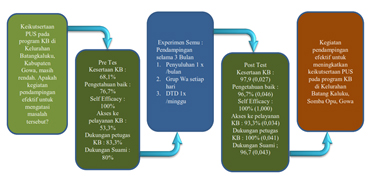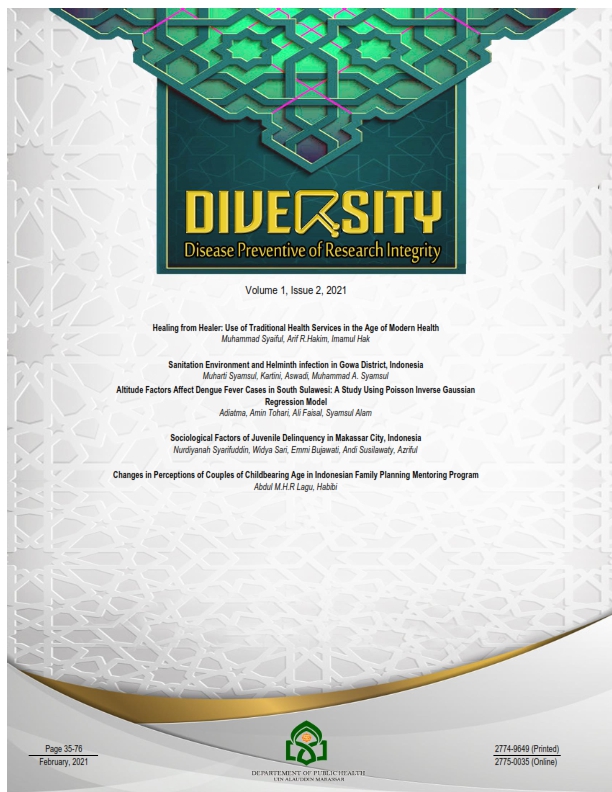Changes in Perceptions of Couples of Childbearing Age in Indonesian Family Planning Mentoring Program
Abstract
The family planning program in general forms a small family according to the socio-economic strength of a family by controlling the birth of a child, to obtain a happy and prosperous family that can meet their daily needs. on the Family Planning Program in Gowa Regency. The type of research used in this study is a quasi-experiment to determine the effectiveness of assistance in increasing the participation of fertile age couples (PUS) in the family planning program located in Batangkaluku Village, Somba Opu District, Gowa Regency. The population in this study were all fertile age couples (PUS) in the area of Batangkaluku Village, Somba Opu District, Gowa Regency, totaling 1,537 people. The number of samples in this study was 94 Fertile Age Couples (PUS). The research instrument used in this study is a questionnaire containing several questions to obtain accurate and objective data on the problems being studied. The results showed that there are factors that influence the participation of fertile age couples (PUS) in the family planning program, namely knowledge, self-efficacy, access to family planning services, support for family planning officers, and husband's support. This study recommends health workers increase the frequency of conducting family planning counseling to increase knowledge of contraceptives in the community.

Downloads
References
Badan Pusat Statistik (2018). Kabupaten Gowa dalam Angka. Pemerintah Kabupaten Gowa.
Bakri, Z., Kundre, R., & Bidjuni, H. (2019). Faktor-Faktor yang Berhubungan dengan Pemilihan Metode Kontrasepsi pada Wanita Usia Subur di Wilayah Kerja Puskesmas Ranotana Weru. Jurnal Keperawatan, 7(1).
Fitria, R., & Darmawati, D. (2017). Faktor Yang Mempengaruhi Partisipasi Suami Dalam Program Keluarga Berencana. Jurnal Ilmiah Mahasiswa Fakultas Keperawatan, 2(3).
Hakim, A. R. (2013). Faktor-Faktor Yang Mempengaruhi Partisipasi Pasangan Usia Subur Dalamprogram Kbdi Kecamatan Kauman Kabupaten Ponorogo. Swara Bhumi, 2(3).
Hamzah, W., Sulaiman, U., Batara, A. S., & Syam, N. (2018). Self Efficacy Correlations to Use Contraceptive Equipment on Couples of Childbearing Age, Kelurahan Tallo, City of Makassar. Window of Health: Jurnal Kesehatan, 373-381.
Kamsatun, K., & Elis, E. (2018). Self Efficacy of Family Planning Acceptors in Selecting Contraception Methods. Journal of Maternity Care and Reproductive Health, 1(1).
Kaseuntung, C., Kundre, R., & Bataha, Y. (2015). Pengaruh penyuluhan kesehatan terhadap pengetahuan Wanita Usia Subur (WUS) dalam pemilihan kontrasepsi di Desa Kalama Darat Kecamatan Tamako Kepulauan Sangihe. Jurnal Keperawatan, 3(3).
Kementerian Kesehatan RI. (2018). Profil Kesehatan Indonesia Tahun 2017.
Khairunnisa, I., Purwanti, S. K. M., & Wijayanti, A. C. (2018). Faktor-faktor yang Berhubungan dengan Minat Pasangan Usia Subur dalam Mengikuti Program KB di Desa Jaraksari, Kabupaten Wonosobo (Doctoral dissertation, Universitas muhammadiyah Surakarta).
Kurniasari, N. D., Hariastuti, I., & Pardiono, P. (2018). Pemahaman Remaja Tentang Kesehatan Reproduksi (Pernikahan Dini dan Perilaku Beresiko) di Sampang Madura. Jurnal Komunikasi, 12(1), 74-85.
Lagu, A. M. H., Raodhah, S., Surahmawati, S., & Nursia, N. (2020). Faktor-Faktor Yang Berhubungan Dengan Keikutsertaan Pasangan Usia Subur Terhadap Program Keluarga Berencana Di Kabupaten Gowa. Al-Sihah: The Public Health Science Journal, 11(2).
Nasrulloh, A. (2015). Hubungan Antara Pengetahuan, Sikap, Dan Dukungan Keluarga Dengan Keikutsertaan Pasangan Usia Subur (PUS) Dalam Ber-KB Di Wilayah Kerja Puskesmas Purwosari Kota Surakarta (Doctoral dissertation, Universitas Muhammadiyah Surakarta).
Natalia, I. W. (2016). Strategi Komunikasi Perwakilan BKKBN Provinsi Jawa Timur dalam Mensosialisasikan Pemahaman Pendewasaan Usia Perkawinan (PUP) Kepada Remaja Menuju Keluarga Kecil Bahagia Sejahtera. Jurnal Jejaring Administrasi Publik, 8(1).
Pradini, D. I., Paratmanitya, Y., & Pamungkas, D. M. (2013). Tingkat Ekonomi Keluarga Berhubungan dengan Pemilihan Alat Kontrasepsi di Dukuh Manukan Sendangsari Pajangan Bantul. Jurnal Ners dan Kebidanan Indonesia, 1(2), 55-60.
Prasetyo, T. (2013) Analisis Faktor Yang Mempengaruhi PUS Mengikuti Keluarga Berencana (KB) Di Wilayah Kerja Puskesmas Sambirejo Kabupaten Sragen. [hesis, Universitas Muhammadiyah Surakarta]
Purba, J. T. (2009). Faktor-Faktor yang Mempengaruhi Pemakaian Alat Kontrasepsi pada Istri PUS di Kec. Rambah Kab. Rokan Hulu Tahun 2008 (Doctoral dissertation, Tesis).
Puspita, S. D. (2019). Dukungan Istri, Peran Petugas KB dalam Peningkatan Partisipasi Pria dalam Keluarga Berencana. ARTERI: Jurnal Ilmu Kesehatan, 1(1), 43-49.
Sari, T. D. K. (2013). Respon Pasangan Usia Subur (Pus) terhadap Program Kb Gratis di Kelurahan Buntu Bedimbar Kecamatan Tanjung Morawa Kabupaten Deli Derdang. Welfare StatE, 2(1), 222012.
Suparman, N., Sakti, F. T., & Engkus, E. (2018). Evaluasi Program Keluarga Berencana pada Era Desentralisasi di Kuningan Jawa Barat. JPPUMA: Jurnal Ilmu Pemerintahan dan Sosial Politik UMA (Journal of Governance and Political Social UMA), 6(2), 122-131.
Wahyuni, A. S. (2015). Hubungan Antara Self Efficacy Dan Sikap Pria Terhadap Penggunaan Alat Kontrasepsi Pada Pria Di Kelurahan Tarok Dipo Kota Bukittinggi (Doctoral dissertation, Universitas Andalas).
Copyright (c) 2021 Abdul Majid H.R. Lagu, Habibi

This work is licensed under a Creative Commons Attribution-NonCommercial-ShareAlike 4.0 International License.
Authors retain copyright and grant the journal right of first publication with the work simultaneously licensed under a Creative Commons Attribution-NonCommercial-ShareAlike 4.0 International License that allows others to share the work with an acknowledgment of the work's authorship and initial publication in this journal.
Authors are able to enter into separate, additional contractual arrangements for the non-exclusive distribution of the journal's published version of the work (e.g., post it to an institutional repository or publish it in a book), with an acknowledgment of its initial publication in this journal.
Authors are permitted to publish their work online in third parties as it can lead to wider dissemination of the work.




